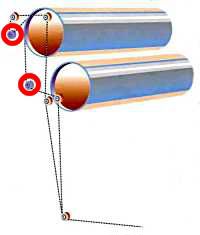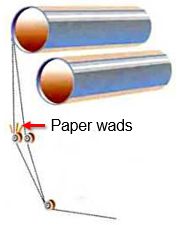Troubleshooting rope runs - the four most common problem areas
Apr 16, 2019
Rope systems or rope runs are many and varied throughout the paper industry, and they are customized to paper machines. The rope system of the paper machine runs from the press section to the reel - not all in one loop, but multiple loops working together for one purpose. And that purpose is to help the operator thread the machine at start-up.
Rope runs grip the tail of the sheet and carry it smoothly through the various sections of the paper machine. In general, rope runs are a necessary nuisance. Required to thread the sheet through the machine, they are in use but a few minutes a day. The rest of the time they just run and can be the source of high maintenance and downtime on the machine.
Ropes twist, turn and travel up and down, riding over a series of pulleys or sheaves. Although rope runs can be quite complex, the vast majority are of good design and add significantly to machine performance.
Conversely, poorly designed rope runs can cause all kinds of misery for the operator, thus cutting deeply into the machine's efficiency. As machines are rebuilt and speeds increase, rope problems also increase. Therefore, mills should assess a system from time to time to find and correct problem areas.
Some of the problems that plague a rope run are: paper jams or "wads," friction between passing rope and paper debris, wads passing through a sheave displacing the rope, twisted ropes, wear and deep rope grooves in older dryers.
Paper wads
Paper jams or wads are an accumulation of paper tails that become entangled in ropes. They are often created in the rope run as a byproduct of the threading operation.
Wads often occur at a tail drop - the terminal point in the threading process where the tail should drop clear of the ropes as the sheet, being fed into the next machine section, widens. Instead of dropping clear, to be picked up later, the tail follows the outgoing rope and may collect at the next sheave and displace the rope.
In assessing rope runs, mills should find the source of wads and correct it. The usual sources are bad tail transfers or poor tail drops. A poorly designed rope run can also create wads by tearing the tail at transfers. Machine operators should NOT accept living with wads as part of normal operations.

Twisted ropes are uncommon, but can occur. A twisted rope run can prevent a clean tail drop and pull the tail into a sheave. This creates wads and problems in the rope run that will damage the tail during threading.
Although rope runs are customized to the paper machine they serve, rope runs should make use of kicker sheaves. These sheaves reduce paper wads during transfers and tail drops. They are called kickers because they literally kick the residual paper tail off the rope and away from the outgoing ropes, nip points and structural devices.

Rope wear
During operation, a rope run is under tension and in constant contact with sheaves - a combination that adds up to rope wear. This wear develops from the rope constantly running through the sheave groove or from driving the sheave. Rope wear increases if the sheave suffers from drag, possibly due to a faulty bearing.
Rope wear also can be produced by ropes rubbing against other ropes on return runs, adjacent sections, crossovers, and in sheaves running two or more ropes. In addition, the angle at which a rope comes off a sheave can cause wear and should not exceed 10 degrees.
Severe rope wear can result from paper wads that end up as hard jams. Thus, mills need to keep wad deposits away from holes in the floor where the rope travels, from pulper walls, from rope nips after the tail drop, and from inboard mounted brackets.
Where rope systems have separate rope drives, they use freewheeling sheaves. The high rope tensions created from driving so many sheaves, plus the acceleration they require, can cause slippage, which, in turn, can produce rope wear.
Sheave wear is also a big contributor to rope wear, and the condition of the sheaves should be constantly monitored.
Rope burning
When the outer fibers of a rope are melted or appear glazed and brittle, it usually indicates a high frictional drag someplace in the rope loop. It also may indicate a bad bearing in a sheave or that the rope has been displaced out of its sheave and is dragging on some stationary object, such as a sheave pin. This type of melt can encompass the entire rope loop or just a portion of it.
If the melt spots appear local, over short distances in the rope loop, this usually indicates that the rope has been in contact with a rotating element in an adjacent section while its respective section has been stopped. This type of failure is usually referred to as burnt rope.
Deep rope grooves

Despite their potentially troublesome nature, rope runs are important to machine operation and efficiency. But the papermaker must be alert to the need for proper rope run design and maintenance. For more information on rope runs and threading, contact your Valmet representative.